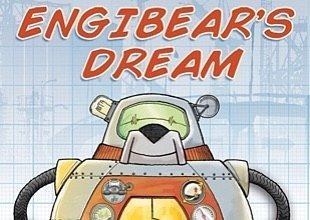Featured Illustrator - Benjamin Johnston
March 6th, 2019
Meet Benjamin Johnston, the illustrator of Engibear’s Dream, written by Andrew King.
Benjamin works full-time as a registered architect, however drawing and illustration have always been his passion. A father of two, the opportunity of seeing life again through children’s eyes is a major influence in the creation of his work. Under the name “Unfold Design”, Benjamin has also explored many other design fields from graphic design through to furniture and object design
We asked him some questions about his influences so you can get to know him better.
How did you get into illustration?
I've always loved drawing and cartooning. And I also had a great attachment as a child to picture books, even as I grew older. So those two loves just kept quietly buzzing around in the back of my head even while I went off and did "real world" stuff like school and university and full-time work. While I work in a creative field (architecture) it isn't as creative as you might think or like. I wanted to re-discover drawing so I regularly returned to things like life-drawing courses and also did an adult education course in Commercial illustration.
When did you decide you wanted to illustrate a picture book?
In 2006 I did Donna Rawlins / Wayne Harris' Children's book illustration adult ed course, run through Sydney University. That set the direction and drive and I knew this was what I wanted to do. It is also a great introduction to realising how the industry works (and to be honest, how tough it is to make it financially stack up)
Why did you want to be a writer/illustrator?
I am now a father of two girls. It was seeing the world of children again through them that pulled me backwards in time and I remembered how much I loved reading children’s books. Since then I have re-discovered a world of wonderful illustrators and authors that I admire and generally have a major crush on.
When did you illustrate your first picture book?
After the course I spent some time creating a decent enough portfolio of works that I could send out. I sent it to as many publishers as I could, and quite some time later I was contacted by Little Steps to illustrate a children's book Angry Mangry, written by teacher Barton Williams.
When you've been contracted to illustrate a book, what is the first thing you do?
I try and make sure I read the manuscript really well, a few times over. I don't want to start on anything heading in the wrong direction. I then find it's best just to leave it for a few days and go about other things. In this way, I'm mulling over the text and trying to work out what's the most important idea and how best a medium or style to bring that out... Then when I can't wait any longer I'll start doodling - particularly character development.
What medium do you prefer to work in?
I'm still working that out - almost everything I have done so far has been a different medium. But coloured linework seems to be the most regular (e.g. black and white lines coloured either in watercolour or digitally).
Could you outline your process for us, so us less artistically talented then you can understand the what steps go into illustrating a book
Depends on the medium - but one thing I like to do is program it. I want to know I have enough time. So I'll often try one image from rough through to final and see how long that has taken. From there I can estimate how long I'll need to do the lot. Here you have to remember I don’t do this full-time so it's difficult to put a timescale on it. I try to work around 10 hour a week. On average so far it has taken me around 12 months to do a book all the way through from start (character development) to finish (finished artwork).
a) Storyboards
b) Full sized outlines
c) 1 double page spread
d) Final art
e) A whole picture book from start to finish
a) Storyboards
b) Full sized outlines
c) 1 double page spread
d) Final art
e) A whole picture book from start to finish
The latest book I did was fully watercolour. One of the most challenging parts to that was producing the whole book but keeping the colours of the characters the same consistent colour all the way through
Again - depending on the medium - I like to try and create some sort of visual reference (a dummy book) as I go - so I can see what pages I have still to go and what I still have to tidy up. I like to immerse myself in music (often with headphones) while I work because it helps me lose myself in the illustration process. As to what...it depends on my mood at the time.
How to you decide what a character is going to look like?
Usually after a lot of experimentation and character development sketching. This is where I guess your own "style" or "look" finally comes into play.... you can't escape entirely just an internal aesthetic decision about what looks right to you or not. I'm still struggling to represent different ages effectively. It involves a lot of "feeling your way". Ideas form - usually not initially clearly, just a feeling - and then you try and translate that to a drawn image. Most times it frustratingly doesn't feel like you are getting close to the fuzzy image in your mind but then it begins to click. Once you are happier with the result, that when you refine and sharpen it up.
Do you have any other jobs or do you illustrate full time?
I work full time as the director of an architecture firm. At the end of each day I might have between 10pm - 1am to do some illustration work... if I'm lucky and I don't have some other more pressing matter (like sleep).
What is the hardest part about illustrating a children's book?
Getting over self-doubt. I love to be inspired by what other illustrators are doing but the flipside of this is I'm constantly doubting if what I am producing is good enough, professional enough.
What is your favourite part about illustrating a children's book?
The storyboard is far and away my favourite part. I think this part of the process is the most mentally challenging - thinking about structure, perspective (viewpoint), flow and relevance for the text. It is also the part that most reflects other design professions - it is the "concept" - the part where you are trying to answer the brief. And the brief in this case is you have been given a text and it is your job to bring that to life and do it justice. If you don't have the initial concept right, all the beautiful renderings in the world won't save it.
What's your favourite picture book of all time?
That's a tough one. I have lots of personal favourites so I'm going to have to stretch it to three. I grew up loving The Just So Stories by Rudyard Kipling. Secondly you just can't go past Where the Wild Things Are by Maurice Sendak. Finally I have a No.1 favourite book that always stayed with me called The Lion's Cavalcade by Alan Aldridge. Not that well know, but the intricacy and detail of the illustrations is truly amazing.
What’s one piece of advice you would give to anyone illustrating a picture book for the first time?
Ask advice from other illustrators. They will always be generous with their time and experience and it will really help you. Join a group like SCBWI for example.
If you could tell your younger self any advice, what would it be?
Have more confidence to try the unusual, left-of-field ideas and pursuits in life. I don't regret anything about my life, but there are sometimes missed opportunities that we lose because we have played it safe.
Tell us a fact about yourself that nobody knows.
When I was 14 or 15, I illustrated my own story that I wrote for my best friend who had never been given a middle name by his parents. So as a kid he gave himself one. It was Tommy Turtle Popsy Bonky. In my story Tommy Turtle was, well, a turtle and Popsy Bonky was a Jack-in-the box. They were trying to hitch a ride to visit Tommy’s Aunt. The plot was shamelessly lifted from Hilda the hen, but don’t tell my friend because he loved it.
Finally, have you had any funny or embarrassing moment as an illustrator?
So far my favourite work that I have illustrated is Engibear – who is a (slightly tubby) engineering bear and the main character in Engibear’s Dream, written by real-life engineer and author Andrew King. I live in Sydney and Andrew in Brisbane, so it was a long time before we actually met. What struck me once we did finally meet was how much the character I had created actually resembled the author (sorry Andrew) – we both had a bit of a laugh about it!
Visit www.engibears.com to learn more about the book
Facebook
Instagram
https://unfolddesign.wordpress.com
https://unfolddesign.wordpress.com

Engibear's Dream
Meet Engibear...
This engineer dreams of designs and starts building a Bearbot to help him at work.
Early versions fail - often spectacularly.
However, Engibear keeps trying.
Follow him as his designs improve and the amazing Bearbot takes shape.
find out more
This engineer dreams of designs and starts building a Bearbot to help him at work.
Early versions fail - often spectacularly.
However, Engibear keeps trying.
Follow him as his designs improve and the amazing Bearbot takes shape.
find out more
Tags: children, art, kids, kidslit, picture book, publishing, self publishing
Comments (0)
No comments have been submitted yet.
Why not be the first to send us your thoughts
Leave A Comment
Thank you for your comments,
they will appear shortly once approved.
TOPICS
RECENT POSTSHAVE YOU SEEN...1
Meet Wendy Goucher, author of Eesha and the Mud Monster MysteryMarch 11th, 20242
Ride the latest wave with Samantha Bell, author of The Girl Who Saved the Ocean.April 21st, 20233
Behind the Story and Illustrations of The Great Guinea Pig Adventures with Hollie SmithFebruary 23rd, 20224
Behind the Illustration Process of Karma and Koo with Emma StuartDecember 16th, 20215
Inside the Inspiration for The Great Guinea Pig Adventures with Hollie SmithNovember 24th, 20211
Meet and Greet - Introducing the Kids to Your Partner for the First Time by Rachel BraceJuly 28th, 20212
Top Tips on How to Write a Junior Fiction/Middle Grade BookJuly 30th, 20213
Meet Chi Mary KaluOctober 29th, 20194
Get to Know Beverly Jatwani, Author of Pedro the Puerto Rican Parrot!May 5th, 20215
Inside the Inspiration for The Great Guinea Pig Adventures with Hollie SmithNovember 24th, 2021